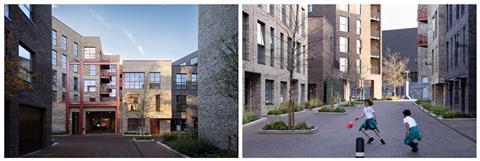Storytelling is integral to who we are as human beings, and plays a central role in highlighting the value in what architects do, writes Chris Hopkinson

Storytelling is hard wired into humans. It’s what we’ve done for thousands of years, round fires and in caves, through drawing, dance, theatre, modern cinema, and more recently through other new digital media. Stories help share a vision, and create connection.
They should be central to the way in which architects shape the built environment with their work, creating spaces for people to connect in and spend much of their lives in. So why are so many architects so bad at storytelling?
Architecture is a profession that we’re told is rooted in maths and physics. Students who excel in these areas are often the ones with personalities focussed on details, cautious in behaviour, and more interested in facts than emotions. While this isn’t a rule by any stretch, it does provide some insight into the type of people we see becoming architects.
This generalisation is supported by research undertaken in 2011 by Robert Gaarder, a lecturer in management and leadership at George Washington University. Using the Myers-Briggs personality type scale, Gaarder found that within a sample of over 100 architects, 31% were ENTJs (Extroverted Intuitive Thinking Judging) and 20% were INTJs (Introverted, Intuitive, Thinking, and Judging).
This compares to just 1.8% of ENTJs and 2.1% for INTJs in the wider population. And if we momentarily suspend our scepticism regarding these types of assessments, this means that about half of architects are Thinking rather than Feeling; Intuitive rather than Sensing, and Judging rather than Perceiving.
Gaader’s sample points to a trend in architects’ personality traits. This is now so widely recognised in Myers-Briggs circles, that the INTJ type is coloquially known as “the Architect”.
Both INTJ and ENTJ are perceived as being either dismissive of emotions, or poor at handling emotions. They are also informed, independent and efficient, putting a lot of faith in data, and their own knowledge and abilities.
As a more fact and figures based community, we sometimes tend to overlook the emotional connection that makes architecture important to individuals, and makes marketing tick.
Emotion and relatability is used on us every single day, from McDonald’s adverts showing families bonding over their food, to Always’ “#likeagirl” campaign. While marketing an architecture firm is on a whole different level to these campaigns, using storytelling and emotion to convey a practice’s value, is still central to conveying the intrinsic value that their design adds to the client/developer.
Practices values might focus on one of several subjects, such as:
• Sustainability
• Social consciousness
• Aesthetics
• Value on a limited budget
• User experience
• Luxury
Once a practice has decided what values they want to promote, and how they would like to appear to the world, their marketing can be geared towards that end. This might include photography or a short video or series of videos of their past projects, with information on how they tackled the challenges, rose to them, developed their knowledge toward that issue, and learned from their past projects.

It might contain interviews with people who have used the buildings, alongside footage of the spaces in use, allowing future clients to see and hear how value is added by the practice. The practices can also consider who they are selling to, and why their photos are important.
For many, they are trying to appeal to developers or direct to residents. In both these situations, both money, and creating architecture that is appealing to live/work in is an important end goal (the developer can’t sell or rent property without this factor).
So ultimately, the media the architect acquires should be geared towards showing off the liveability of a building or area. Being able to show or describe the building as being relatable and comfortable, and not being an abstract, empty, pristine structure, makes people more predisposed to it.
As a very visual person, this aspect of the synergy between marketing and architecture has caught my attention. Whether it’s showing photos with fleeting, blurred glimpses of people in the spaces, builders at work on construction sites, or my grandma talking about her house and filming her using the spaces, among her belongings, these things all tell the story of a building, and pull us in to pay attention to who you are and what you’re creating or selling.
This can leave a much deeper impression than presenting a beautifully presented space devoid of people or any of life’s quirks or idiosyncrasies.
Both the images below were shot on the same day at East Wick & Sweetwater, in East London for Studio Egret West. Both are effective at communicating the architecture, materiality, scale and lighting conditions present. The one on the right shows people enjoying the space, interacting with it, and emotes feelings of joy and ease with a location, connecting us with it on an emotional level.

In digital renders of new neighbourhoods and larger developments, people are often included. That is sometimes missing from final images, and it can be easier to enforce the connection with video. This resonance with emotion can be used as leverage to attract media, and future clients to projects and practices.
Film and photography can help architects tell stories and to “sell” their work more effectively.
Postscript
Chris Hopkinson is the founder of Chromaphotography
















No comments yet